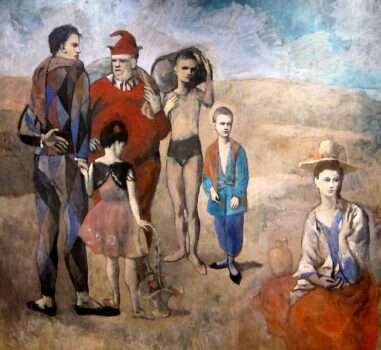The Family of Saltimbanques Painting by Pablo Picasso
In the early 20th century, Pablo Picasso, a young artist barely in his twenties, painted one of the most enigmatic and emotionally charged works of his early career: The Family of Saltimbanques (1905). Set against a desolate, arid landscape and populated by a troupe of traveling performers, the painting draws the viewer into a scene of quiet melancholy and subtle symbolism. At first glance, it appears deceptively simple, a group portrait of circus performers resting between shows, but upon deeper reflection, it reveals layers of meaning about identity, alienation, and the human condition.
Who Painted It and When
Pablo Picasso painted The Family of Saltimbanques in 1905, during the latter half of what is now called his Rose Period (1904–1906). At this time, Picasso had recently relocated to Paris and was living in extreme poverty in Montmartre, then a bohemian quarter full of artists, writers, and vagabonds. Having already moved past the intense sadness of his earlier Blue Period, where he depicted beggars, the blind, and mourners in cold, monochromatic blue tones, Picasso entered a phase that used warmer pinks, reds, and ochres.
But while the color palette of the Rose Period is warmer, it would be a mistake to think the emotions were more joyful. The Family of Saltimbanques, measuring nearly seven feet wide and five feet tall, was created in this transitional moment. The painting shows that while the external world might seem more colorful, the internal world of the artist and his subjects remains haunted by isolation and introspection.
Picasso was just 24 years old when he painted this monumental canvas, yet his vision of the human experience was already sophisticated and profound. He drew inspiration from his environment, circus performers, acrobats, and harlequins who often appeared in Parisian cabarets and traveling shows. These figures, on the fringes of society, fascinated him. They lived lives of performance and spectacle but were often lonely and marginalized, outsiders in the truest sense.
What Is Happening in the Painting?
The Family of Saltimbanques presents six figures: three adults, two children, and a young boy standing apart. All are dressed as circus performers, known in French as saltimbanques, a term that conjures up images of traveling entertainers, acrobats, and jesters. The group stands in an expansive, empty landscape with no discernible landmarks. There is no tent, stage, or audience. They appear isolated, not only from the world but from each other.
At the center is a tall, statuesque woman dressed in a coral-red leotard and blue tights, often identified as the central figure. To her left stands a young boy with his hands in his pockets, gazing pensively into the distance. A young girl in a pink dress sits on the ground near a basket of fruit, while a harlequin crouches beside her, seemingly lost in thought. To the right, two adult male figures, a juggler or acrobat and a portly man in a buffoonish costume, stand together but apart, both looking in different directions.
There is almost no interaction among the figures. They occupy the same space but exist in separate emotional worlds. Their poses are languid, their expressions solemn. The absence of a performance or audience turns them from entertainers into existential figures, caught between roles, identities, and destinies.
Symbolism and Interpretation: The Many Meanings Behind the Faces
1. The Saltimbanque as a Metaphor
Saltimbanques were common subjects in 19th-century European art, often symbolizing the misunderstood artist, the outsider, or the tragic figure. For Picasso, they were a mirror to his own experience, isolated, impoverished, and misunderstood despite living in a city full of energy and art. The figures in the painting are both individuals and allegories. They suggest a parallel between the life of a performer and the life of an artist: both must wear masks, travel constantly, and entertain others while suppressing their own inner lives.
2. Emotional Alienation
One of the most striking aspects of the painting is the lack of connection between the figures. Despite their proximity, they do not speak, look at, or touch each other. Art historians interpret this as a meditation on loneliness and the existential separation of human beings. It may reflect Picasso’s own emotional state at the time, struggling to connect with others despite being surrounded by people.
3. Autobiographical Elements
Many scholars believe that Picasso included himself in the painting in the form of the young harlequin squatting on the left. Harlequins were recurring figures in his work, often serving as self-portraits. If this is true, the painting becomes even more personal, a quiet commentary on his place in the world, his alienation, and his desire to be seen beyond the costume he wears.
The tall female figure is thought to be based on Fernande Olivier, Picasso’s muse and companion at the time. Their relationship was complex and passionate, and the central placement of this figure suggests the importance of her emotional presence in his life. The other performers may represent Picasso’s circle of friends or broader ideas about the roles people play in society.
4. Time Between Performances
This is not a moment of performance, but one of pause. There’s a quietness to the composition, almost like a still life. The basket of fruit near the young girl further reinforces this. It symbolizes domesticity and simplicity, a stark contrast to the theatrical world these characters inhabit. This moment of repose could suggest the rare, raw moments when performers (or people in general) remove their public faces and confront their inner lives.
What Type of Art Is This?
The Family of Saltimbanques is part of Picasso’s Rose Period, characterized by a lighter palette and a focus on harlequins, circus performers, and acrobats. While still rooted in realism, the figures show a move toward stylization that foreshadows Picasso’s later Cubist experiments.
The painting also bears traces of classical influence. The careful composition and monumental scale recall Renaissance frescoes or history paintings, lending the humble saltimbanques an almost mythic dignity. This juxtaposition, between the grand scale and the modest subject, heightens the emotional resonance of the work.
Stylistically, the work bridges Symbolism and Modernism. The sparse landscape and dreamlike stillness evoke Symbolist moods, while the psychological focus and simplified forms signal the modernist break from academic traditions. It is a painting that belongs to several traditions while also carving out a unique space for Picasso’s evolving voice.
Comparisons and Influences
Many art historians note the influence of Edgar Degas and Henri Toulouse-Lautrec in the work’s theme and form. Like them, Picasso was fascinated by performers and the spaces behind the scenes. However, unlike Degas, who often depicted the body in motion, Picasso’s performers are frozen in an eternal moment of introspection.
The flattened space and stylized gestures also anticipate later 20th-century trends in abstraction and surrealism. There’s an almost dreamlike ambiguity in the painting that allows it to resonate emotionally even if the narrative remains elusive.
Where Is The Family of Saltimbanques Painting Today?
The Family of Saltimbanques resides in the National Gallery of Art in Washington, D.C., a centerpiece of its modern European collection. Donated by Chester Dale in 1949, the painting remains one of the most celebrated works from Picasso’s early career. It attracts thousands of visitors annually who come to experience the emotional intensity and mystery of this early masterpiece.
A Timeless Meditation on Human Solitude
The Family of Saltimbanques is more than just a painting of performers, it is a visual poem about the solitude we carry, even in the company of others. It is a deeply introspective work that invites viewers to question the roles they play in their own lives, the masks they wear, and the spaces they occupy in relation to those around them.
Picasso, at just 24, managed to create a work that transcended time, capturing a moment that feels both ancient and modern, theatrical and silent, external and deeply personal. Through its symbolic use of saltimbanques, sparse composition, and quiet emotion, the painting remains a cornerstone of early modern art, a reminder that even in the warmth of the Rose Period, the shadows of human complexity remain.
Whether viewed as a self-portrait, a social commentary, or a universal reflection on alienation, The Family of Saltimbanques endures as one of Picasso’s most profound and affecting works, a haunting tableau of stillness, longing, and the quiet performance of life itself.




